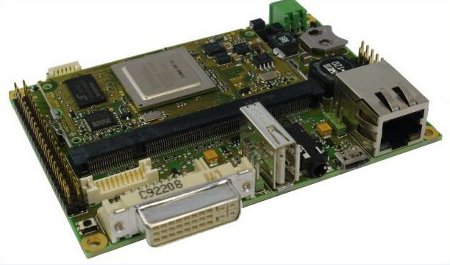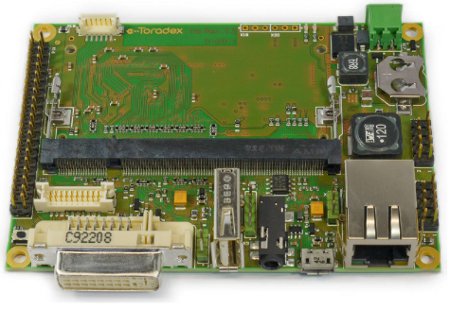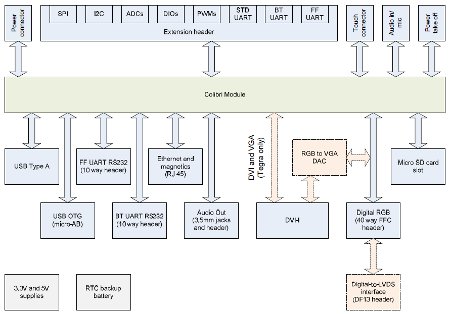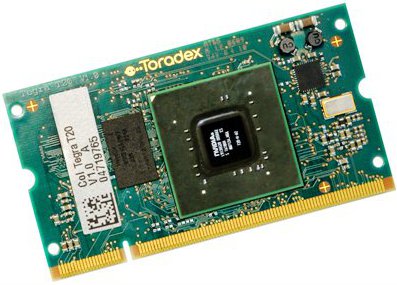Tegra 2 module gains open-spec pico-ITX carrier board
Apr 28, 2011 — by Eric Brown — from the LinuxDevices Archive — 29 viewsToradex launched a pico-ITX carrier board for its Colibri modules, available with free schematics and compatible with Linux or Windows Embedded Compact 7. The Toradex Iris can support any Toradex Colibri module but is available with the Colibri T20 module pre-installed, making it one of the first Nvidia Tegra 2-based development boards, according to the company.
The Iris board measures just 3.94 x 2.84 inches (10 x 7.2cm), adopting Via's pico-ITX format. All schematics and design data are available for the Iris for free on the Toradex website, including the complete Altium Project files.

Toradex Iris with Colibri T20 module
(Click to enlarge)
The Colibri Tegra T20 is the most powerful of a series of Linux-compatible "Colibri" CPU modules. These have previously been based on Marvell PXA processors, such as the PXA320-based Colibri PXA320 module.

Iris without a module
(Click to enlarge)
The Iris is equipped with DVI-I connector and an LVDS interface, and supports dual simultaneous display capability, says Toradex. A resistive touchscreen connector is also available along with a digital RGB interface, says the company.

Iris block diagram
(Click to enlarge)
Most of the I/O is available via headers, all mapped out in detail in the schematics. These include three RS-232 interfaces, as well as I2C, SSP, UARTs, and GPIO.
Features and specifications for the module-less version of the Iris include:
- Flash expansion — microSD slot
- Networking - 10/100 Ethernet (RJ45)
- Display:
- DVI-I connector with digital (TDMS) and analog (VGA) interfaces
- LVDS interface
- Digital RGB interface
- Dual display capability
- Resistive touchscreen connector
- USB — USB Type-A host and OTG Micro-AB host/client ports
- Other I/O (via headers)
- 3 x BT and FF RS-232 interfaces
- SSP
- I2C
- 4 x ADCs
- 4 x PWMs
- 8 x GPIOs
- STD, BT, and FF TTL level UART on header
- Audio — 3.5mm stereo jack; mic and line-in on audio header
- Other features — real-time clock with battery backup
Most Iris customers are likely to use the version with the pre-installed Colibri T20 module. That's because it runs the Tegra T20, also known as the Tegra 250 or simply the Tegra 2. It's the hot mobile processor of the day, especially in the Android tablet field.
The module does not yet offer explicit Android support, but the available Linux option should give designers a good prototyping tool for Android-ready devices. Windows Compact 7 is also available.

Colibri Tegra T20
The Colibri T20 is equipped with 256MB of 32-bit DDR RAM, as well as 1GB of flash storage, says Toradex. The module supports 1080p video playback, with display resolutions up to 1920 × 1080 pixels, says the company. LCD displays are said to be supported at up to 1680 x 1050 resolution, and an HDMI interface is available.
The module supplies a 16-bit external bus, supports dual SD card slots, and offers 10/100Mbps Ethernet support and a high-speed USB host/device interface, says Toradex. Additional I/O is said to include I2C, SPI, IrDA, One-Wire, as well as three UARTs.
As with previous Colibri modules, the Tegra T20 version offers 4/5-wire touch interfaces, as well as camera interfaces, audio I/O, PWM, and GPIOs (up to 110 of them). The 2.66 x 1.44 x 0.20-inch (67.6 × 36.7 × 5.2mm) SODIMM module can withstand temperatures from -4 to 158 deg. F (-20 to 70 deg. C), says Toradex. Power consumption is said to run at less than two Watts.
Availability
The Iris carrier board is available now with Linux or Windows Compact 7 for $179 without a module, or $318 for the version with the Colibri T20, says Toradex. Higher volumes bring prices under $100 for the Iris alone.
Toradex will demonstrate the Iris at ESC (Embedded Systems Conference) Silicon Valley in San Jose next week, May 3-5. More information may be found on the Iris product page.
This article was originally published on LinuxDevices.com and has been donated to the open source community by QuinStreet Inc. Please visit LinuxToday.com for up-to-date news and articles about Linux and open source.